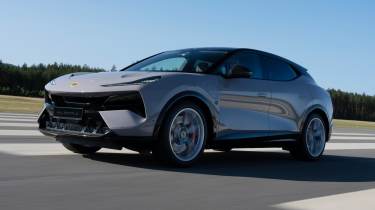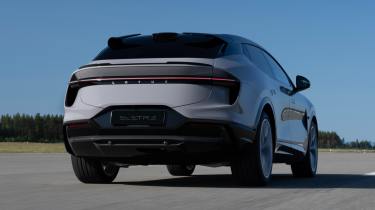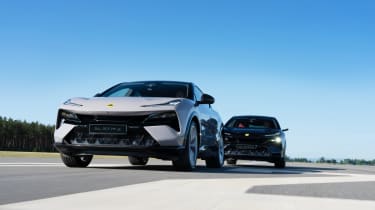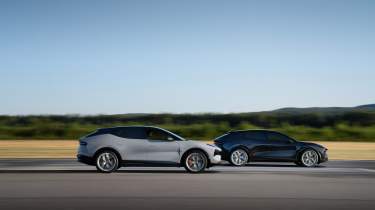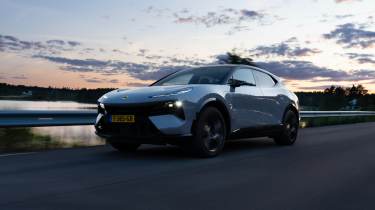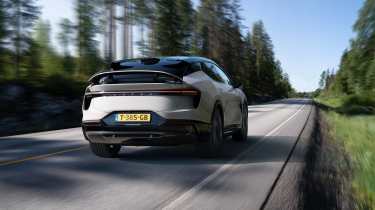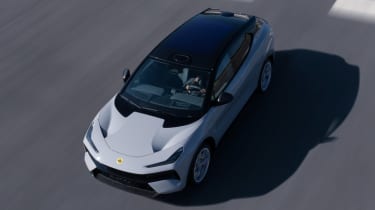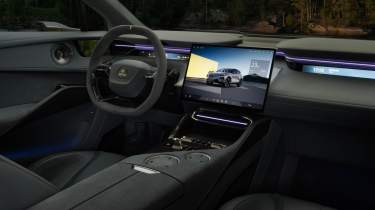Lotus Eletre 2025 review – is Hethel's 'hyper SUV' a Cayenne killer?
The Eletre is the most ambitious Lotus yet, tasked with selling in volumes to shore up the firm's bottom line.
At this point we need to take as read that the Eletre will probably never be accepted as a 'proper Lotus' in the Chapman-approved sense, less we risk treading old ground. The antithetical nature of a Lotus badge atop the snout of 2.5-ton SUV with more power than a Holy Trinity hypercar was obvious the moment the Eletre was unveiled.
There are more important questions to ask of the opening gambit in Lotus’s ‘lifestyle’ offering. For it has the job of selling in numbers like no other Lotus before it, to fund the continued existence of the lithe, light two-seaters that have historically defined the brand, if not so successfully lined the coffers. Namely, is it a good product? Does it deliver what its prospective buyers should reasonably ask of it? A three-week 500-mile dalliance straddling the closing days of 2024 and the opening days of 2025 certainly brought into focus what Lotus has and hasn’t gotten right with the Eletre, or at least the Eletre R that we sampled.
What constitutes an Eletre, or Type 132 as it’s known in long-standing Hethel-born parlance, then? It’s an all-electric high-performance luxury SUV (we’re duty-bound to inform you Lotus calls it a ‘hyper SUV’...) with the likes of the Range Rover Sport and Porsche Cayenne in its sights. In 905bhp Eletre R form, it also takes a swing at the likes of the Aston Martin DBX707 and Lamborghini Urus SE.
More reviews
Lotus tries to distance the Eletre (and the Emeya with which it’s twinned) from its Geely DNA, but the 800-volt 43 per cent advanced aluminium alloy EPA platform is related to the Chinese firm’s ‘Sustainable Experience Architecture’. EPA has undergone significant development to cultivate a bespoke feel, however, with the car’s driving characteristics hewn with oversight and input from renowned Lotus engineer Gavin Kershaw, who has been with the company for 36 years and counting. As the Director of Attributes and Product Integrity, it’s quite literally been his job to ensure the Eletre is as ‘Lotus’ as possible. With that said, a 900bhp 2.5-tonne SUV will have been new even to him.
Speaking of that power, what are the figures? Well, the Eletre R we tested utilises the same 112kW (108kW usable) battery as all Eletres. While all have dual motors, the Eletre R gets a 603bhp rear motor that bumps overall power and torque up to 905bhp and 727lb ft and features a two-speed transmission.
The car is suspended at all four corners by dual-chamber air springs with adjustable height and damping – 500 adjustments a second are possible – with an aluminium multi-link setup front and rear. It also features a 48-volt anti-roll control system and active rear steering. It’s all tied together with Lotus 6D integrated chassis control electronics and adjusted by the driver via drive modes with Tour, Range, Sport, Off-Road, Individual and exclusively for the Eletre R, Track Mode settings. No doubt all pretty alien stuff for a name once associated with the motto ‘simplify and add lightness’.
So what does 905bhp and 727lb ft of instant performance feel like? Unsurprisingly extraordinary, bordering on unpleasant. Exactly how much of the Eletre R’s full force you get depends on what drive mode it’s in. In Range, throttle response is positively lethargic, requiring a proper slug of pedal travel to get you going, meaning the car sips at its energy reserves (relatively speaking) most of the time. By contrast, the Track Mode is as it says on the tin, with comparatively synaptic throttle response to millimetric inputs and a more liberal attitude to traction management. Tour is a less extreme version of Range, just as Sport is a less extreme version of Track.
With good traction and in the right moment, this is performance to express your previously hidden jowls, that’ll create space that once wasn't there between the skin cells on your face, such is the ferocity of the forward motion it can deliver.
Such conditions are, as it happens, rare in darkest Norfolk around Christmas time so the reality of flat-footing the Eletre R is usually the back axle skipping and slipping, as power cuts in and out and the hot potato of limited grip is passed between the rear wheels, while the fronts diligently claw you along.
In all but the best conditions, even wound back from Track to Sport, the impression is of a prototype that’s been turned up to eleven by mischievous engineers looking for an out-of-hours giggle. There’s a pointlessness to it akin to a sunroof option for the space shuttle. It’s barely contained fury rather than a cohesive whole – brute force over fine-tuning, even if there has been plenty of the latter.
Keep your foot in the Eletre R for long enough and you’ll feel a bit of a thud as the acceleration abates momentarily. That’s a rather clunky feeling gear change happening in the rear motor, the head-bob it forces out of you reminding you of noughties paddle-boxed supercars. The full performance figures are as follows: 0-62mph in 2.95sec and a top speed of 165mph.
All told, in spite of being the one thing that should sell the Eletre R, the scarce usability and unhinged nature of its performance is among myriad reasons why the still-potent 603bhp models (0-62mph in 4.5sec and 160mph up top) would suffice for almost all the Eletre-curious.
What does feel really quite well developed is the Eletre’s chassis, and the way it flows down a road. Deploy the necessary amounts of power – far less than the full 905bhp – and in Sport mode, the Eletre tightens up, exhibiting commendable lateral and longitudinal control across an undulating surface. Sudden jolts do arrive with a proper thud in the wheel wells though, sometimes leaving you wondering if it got through unscathed.
The steering is well weighted and well-judged for speed – 2.5 turns lock-to-lock. Feel through the wheel is more tuneful hum than bristling detail, typical of a well-executed EPAS system. Exploring the car’s capabilities is at first a leap of faith, during which you need to develop trust in its sprawling technical appointment and dial yourself in with the car, especially in terms of discipline with the throttle.
As above, two thirds of the R’s punch would be quite enough most of the time. Thankfully the brakes are mightily impressive too (optional 10-piston calipers squeeze carbon discs), with the regenerative and friction elements integrated reasonably well throughout the pedal travel.
Turn in and agility are good, aided by the rear-steering, which unlike some systems is well-integrated and natural enough in feel. Less so in Track, where the Eletre R’s responses are hyperactive. With the traction control wound back, it is more than happy to spit the rear end out with only moderate throttle inputs, with the stiffened suspension settings stunting its ability to ‘breath with the road’ too. All in the dynamic experience is Range Rover Sport SV-like, if not so universally unshakable, with less predictable, spikier, worse-integrated performance. The cohesion of a Cayenne, it does without.
The Eletre really is at its best in the middle, as an A-road grand tourer with globs of motive force in reserve. Wind the Eletre back and it's a worthy mile muncher – intuitive to position on the road with a comfortable ride most of the time. The refinement however, is mixed. There's quite a roar at speed as the asphalt pours out from beneath the (275 front, 315 rear) Pirelli tyres and as air tumbles through the Eletre’s porous bodywork.
The wind noise worsens too when you engage cruise control, as the Lidar sensor deploys where the roof crests above the windscreen, disturbing the air rushing overhead. Even the action of it deploying, like the spoiler coming up, emits an almighty sci-fi whir that could do with being quietened. Speaking of weird noises, the kinds of whirs and hisses you can hear having got out after a journey could have you thinking you’d just brought the USS Enterprise into dock, rather than a car.
A final note on the array of sensors – the roof-mounted lidar is joined by sensors that fold out above the wheelarches. You’d imagine that the Eletre’s sensory appointment and supposed potential for full autonomy would make its assisted driving systems the best in the business, no? They’re not. They’re befuddled when the roads get even remotely rural, the steering tweaking left and right as it tries to sniff out a solid painted line.
Looking at the screen and all the cars and people the scanners can ‘see’, you’re initially impressed. We were too, until the car near-on emergency braked on a dual carriageway, prompted by a van simply driving along in the lane to our left.
Reason number two why the Eletre R really isn’t the one to get: efficiency, or rather, a lack thereof. With 108kWh of usable battery capacity and an initial press release where the word ‘efficiency’ is used ten times, in reference to materials, technology and componentry employed to improve it, you’d hope it could offer some. Sadly not.
An important note is that this car was tested over the course of the 2024 festive period, including a biting cold snap. But we drove it how buyers likely will, which is to say, using the gimmicky performance a few times before just living with it.
Nevertheless, with mixed to careful driving – a lot of coasting, a lot of careful regenerative braking use, but still with accelerations and motorway speeds – we got in the region of 200 miles from a full charge. That’s an efficiency rating of less than two miles per kWh of battery capacity. Trying our best and in normal temperatures, the range ought to go up to 230-240 miles. In any case, the Eletre R is way down, both on most other EVs in this price point, its lower-spec siblings and indeed, the stated figure of 317 miles. In our testing, it underperformed by over a third. We're morbidly curious about testing what it'd be like towing.
This is all bad of course but by far the worst thing is that it couldn’t keep up with its own inefficiency, grossly overestimating the range it had left by tens of miles at a time. The hyper hybrid range extender Eletre due next year, can't arrive soon enough.
Then there’s the cost. Any EV owner should really have home charging set up, with a box and a friendly tariff to boot, because the £92 it costs to go 200 miles in an Eletre R, if charged publically on a 150kW charger, isn’t sustainable. The cost/consumption equivalency is more like a supercar on a track evening than an EV, or indeed, combustion super SUVs good for 250-300 miles on a ‘tank’. Granted, their tanks often cost more to fill.
With an 800-volt architecture, the Eletre is good for 350kW charging and when plugged in, it was happy enough to gulp the electrons down as fast as chargers would feed it. During a cold session with no pre-conditioning, we saw it go from 13 to 80 per cent in 43 minutes.
The aforementioned drive modes are controlled by the split paddle behind the steering wheel on the right, while the one on the left controls the variable regenerative braking. The intensity of the regen ranges from level four, which feels like a really firm press of the brake pedal and one, which is a bit softer than engine braking. You can also switch it all the way off if you subscribe to the ‘coast as much as possible’ school of EV efficiency. Either way, the Eletre was an electronoholic.
The interior is a mixed bag of hits and misses. Let’s offer it some respite. The digital UX and 15.1-inch touch screen didn’t drop a frame for the whole three weeks of the test, was incredibly slick, high-definition and crash free.
Once you work it out, it’s also a bit more common sense than most multi-menu interfaces that hide key controls out of safe reach. We didn’t even feel compelled to default to pairing a smartphone, content with firing up the native Spotify app and keeping the efficiency graphs close to hand.
The minimalist driver’s display and HUD was surprisingly well thought-out too. Such little physical realestate up ahead might worry at first but everything you need is there and clear to see and changes with the driving modes. In track, it’ll show a G meter. In off-road mode, it’ll show you the car’s lateral and longitudinal angles of orientation. The numbers you’re always looking at are the respective indicated range and battery percentage. Surprisingly inoffensive were the digital mirrors, which at night offered a much better view rearward than an ordinary mirror would. Still wouldn’t have them, though.
Downsides? Every time you get in the Eletre to go for a drive, the nagging speed and lane departure systems need to be re-extinguished. The sliders to get rid of them are two menus deep, with the lane departure demanding you double check that you want it gone. And you do, because as above, it’s not very good.
In terms of quality, the Eletre really is hit and miss. The design inside is ace, if a bit chintzy for some tastes. The wheel in spite of being gratuitously futuristic on first impression is quite nice, clad in Alcantara and carbon as it is. The physical controls feel quality and make sense, and the size and thickness are judged well all around – it’s a pleasure to use and properly complements how the Eletre feels to drive.
Some of the fit, finish and material use is fabulous – the physical temperature controls for instance, as well as the drive selector, are weighty and tactile. The wish for more physical stuff isn’t just an ergonomic one, but one informed by the tactility of what is physical.
Some of the quality and tech is less impressive. The bolster of the driver’s seat, for instance, showed wear you’d associate with something much older than our 5000-mile test car. The Eletre also struggles to warm up inside and clear its windows on a cold day, in spite of having a heat pump. We’d probably skip the £3100 KEF Reference Audio, too. A final gripe? The alarm once howled when parked, even with the key in the car.
Overall, niggles aside, it’s a nice, comfortable place to be for all occupants, especially at night when all the screens, mood lighting and disparate materials make it feel like a car from Cyberpunk 2077 come to life.
Even aside from the pink-undertoned ‘Blossom Grey’ paint of our test car, the Eletre’s exterior looks are a topic of debate. In our echo chamber of devout performance car enthusiasm, any Lotus that isn’t a tiny, shrink-wrapped mid-engined two-seater will be dismissed as heinous.
The general public, on the other hand, seemed to love it. Wrong ’uns, the lot of ‘em. Want more attention? You’ll need a supercar. If the job of a big SUV is to have presence and visual appeal to the masses, for buyers that want to be seen and impress, then it’s a big tick for the Eletre. It's better looking than the BMW XM, at least.
Price and rivals
With liberal tapping of the incongruously vast power reserves, it’s a satisfying steer up there with the Range Rover Sport SV and Aston Martin DBX707. On the other end of the scale, less direct or overtly sporty electric rivals include the BMW iX and from within the Geely family itself, the Polestar 3.
MoIf the standard Eletres do deliver 300 miles of real world range, they’re the better buy. With the dynamic handling pack, inclusive of the rear-steering and active anti-roll control, an Eletre S will set you back £112,404, rather than the £166,595(!) total our Eletre R came to. The electric mirrors, intelligent glass roof, privacy glass, configurable ambient lighting, sports pedals and Lotus Connect Prestige options are what bumped it up from the R’s £129,950 starting price. Oh, and the weird pink paint and extended carbon inside and out. None are essential.
The question at hand, then. Is this Lotus’s ‘Cayenne moment’? That’s to say, is this a product that will revolutionise its segment and deliver Lotus a secure future? In Eletre R form, sadly not. Quality and the potential residuals are fringe issues. And make or break – and in this case break – is efficiency. There’s plenty turning buyers off EVs at the moment but apart from anything else, we thought range anxiety might be a thing of the past by now. How this car drinks is a reminder of how bad earlier EVs were, rather than a taste of what competitors should aim to emulate.
With its flaws in mind, can one look to a sense of Lotusness for redemption? The Eletre does have its charms, namely the way it drives, but few of them are uniquely Hethel-grown.
Lotus Eletre R specs
| Powertrain | Twin-motor, all-wheel drive |
|---|---|
| Battery | 112kWh (108kWh useable |
| Power | 905bhp |
| Torque | 727lb ft |
| 0-62mph | 2.95sec |
| Top speed | 165mph |
| Weight | 2640kg+ |
| Power-to-weight | 342bhp/ton |
| Range (WLTP combined) | 304 miles(stated), 200-240 miles as tested |
| Price | From £129,950 |
| Price as tested | £166,595 |
